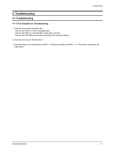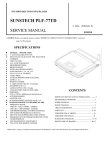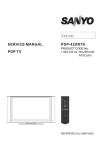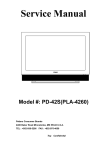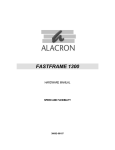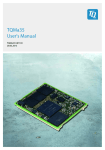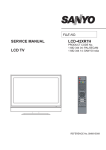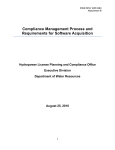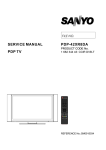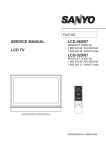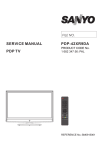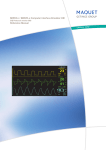Download pdp-42xr7z_sm12.09 MB
Transcript
FILE NO. SERVICE MANUAL PDP-42XR7Z PRODUCT CODE No. PDP TV 1 682 344 45: PAL/SECAM REFERENCE No.: SM0915018 CONTENTS Safety precautions………………………………………………………………………..… 1 Alignment instructions …………………………….…….………………………………… 3 Method of software upgrading…………………………………………………………….. 6 Working principle analysis of the unit……………………………….………….………….13 Block diagram…………………………………..………………………………….…………14 IC block diagram………………………………………………………………………..……15 Wiring diagram ……………………………………………………………………………. 22 Troubleshooting guide ………………………………………………………………..…… 23 Schematic diagram………………………………………………………………………… 32 APPENDIX-A: Assembly list APPENDIX-B: Exploded View Note: This maintenance manual is intended only for the reference of the maintenance people. Please pay attention to the following points before carrying out the maintenance work. Safety Precautions Please read the “Points for attention for the Maintenance & Repair of PDP” and “Criterion for Identifying the Defects on Screen” as below, before inspecting and adjusting the TV set. 1. “Points for attention for the Maintenance & Repair of PDP” To avoid possible danger, damage or jeopardy to health and to prevent PDP screen from new damage, the maintenance people must read the following carefully. If they ignore the following warnings, there will be deathful risks: 1.1 Screens vary from one model to another and therefore not interchangeable. Be sure to use the same type of screen in the replacement. 1.2 The operation voltage is approximately 350V for PDP module (including screen, driving circuit, logic circuit and power module). If you want to conduct maintenance work on PDP module when the set is in normal operation or just after the power is off, you must take proper measures to avoid electric shock and never have direct contact or touch with the circuitry of the working module or metal parts. That’s because within a short time relatively high voltage still remains on the capacitor of the driving part even after the power is off. Make sure to begin relevant maintenance operation at least one minute after the power is off. 1.3 Don’t apply on the module any power supply that is higher than the specification. If the power supply used deviates from the value given in the specification, there might be a possibility of leading to fire or damage to the module. 1.4 Never have operation or mounting work under unsuitable environment such as areas in the vicinity of water – bathroom, laundry, water chute of kitchen – sources of fire, heat-radiation parts or direct exposure to sunlight. Otherwise there will be kickbacks. 1.5 In case foreign substances such as water, liquid, metal slices or others fall into the module carelessly power must be cut off immediately. Keep the module as it is and do not move anything on the module. Otherwise it might be possible to contact the high voltage or cause shock short circuit so that it may lead to fire or electric shock. 1.6 If there is smoke, abnormal smell or sound from the module, please cut the power off immediately. Likewise in case the screen doesn’t work when the power is on or during the operation, please also cut off the power at once. No more operation in this case. 1.7 Do not remove or plug its connection wire when the module is in operation or right after the power is off. That’s because there remains a relatively high voltage on the capacitor of the driving circuit. If there is a need to remove or plug in the connection wire, please wait at least one minute after the power is off. 1.8 Considering the module has a glass faceplate, please avoid extrusion by external force lest it should cause glass breakage that may get people injured. Two people are needed in cooperation to move this module lest contingency takes place. 1.9 The complete TV set is designed on the basis of full consideration of thermal dissipation by convection, with the round hole on the top for heat emission. To avoid overheat, please do not have any covering on the hole during normal operation and never put it in the place where the space is narrow and in bad ventilation. 1.10 There is quite a number of circuits in PDP that are integrated ones. Please be on guard against 1 static electricity. During maintenance operation be sure to cover yourself with anti-static bag and before operation make sure to have it sufficiently grounded. 1.11 There are a big number of connection wires distributed around the screen. Please take care not to touch or scuff them during maintenance or removing the screen, because once they are damaged the screen will fail to work and it’s not possible to repair it. If the connection wires, connectors or components fixed by the thermotropic glue need to disengage when service, please soak the thermotropic glue into the alcohol and then pull them out in case of damage. 1.12 Connector for the circuit board of the screen part is relatively fine and delicate. Please take care in the replacement operation lest it should get damaged. 1.13 Special care must be taken during transportation and handling because strenuous vibration could lead to screen glass breakage or damage on the driving circuitry. Be sure to use a strong outer case to pack it up before transportation or handling. 1.14 Please put it for storage in an environment in which the conditions are under control so as to prevent the temperature and humidity from exceeding the scope stipulated in the specification. For prolonged storage please cover it with anti-moisture bag and have them piled and stored in one place. The environmental conditions are tabulated as below: Temperature Humidity Scope for operation 0~50centigrade Scope for storage -15~60centigrade Scope for operation 20%~80% Scope for storage 20%~80% 1.15 If a fixed picture is displayed for a long time, difference in its brightness and color may occur compared with movable pictures. But it doesn’t show any problem and the reason is that there is reduced density of fluorescent powder in the former. On the other hand, even if changes take place in the picture, it can keep its brightness for a period of time (several minutes). It’s a feature inherent with plasma and it’s not abnormal. However please try as much as possible to avoid showing a still picture of high brightness for a long time during operation. 1.16 As a digitalized display devise, this module is provided with error diffusion technology and the gray scale and false enhancement of contour can be displayed by reusing of sub-field. As compared with cathode ray tube, it can be found in the moving picture that at the brim of the face of a person there are some wrong colors. 1.17 During the display of graph (indicating the gradual change in brightness horizontally or vertically) resulting from gray scale test it can be found that the brightness for the two adjacent levels is uneven. This is caused by the reuse of sub-field, the display of load rectification and the electrolysis. 1.18 The screen front plate is of glass. Please make sure that the screen has been put in place during erection. If it is not in place before the erection begins it may lead to screen crack or breakage. 1.19 Make sure the screw used in the mounting of the screen is of the original specs lest it should cause damage to the screen due to mismatch. Special care should be taken not to use too long or too big screw. 1.20 Care must be taken to guard against dust during assembling or dismantling, especially to avoid dirt from falling in between the screen and the glass lest it should harm the receiving and viewing 2 effect. 1.21 There is piece of insulator stuck on the rear chassis corresponding to the power supply board. It is used to isolate the cool part from the hot part. Please take care to keep it intact lest it should become a potential safety trouble. 1.22 In addition to plasma screen, the glass is a part of high value. It has such functions as anti-radiation, adjustment of color temperature etc. Please handle it carefully. Alignment instructions 1. Test equipment PM5515 (video signal generator) VG-849 (YUV, VGA, HDMI signal generator) CA100 (white balancer) 2. The alignment flow chart (see below figure) Check DDC and FLASH To produce digital board and analog board All testing Adjust white balance Connect with central signal source, then check each function of TV such as station missing, analog control etc., check the output of headphone and speaker Input AV/SVIDEO signal, then check each function of all the terminals Input HD signal (format), then check each function of the terminal Input VGA, HDMI signal, check if the display is normal, check each function such as analog control etc., check horizontal /vertical center etc. Preset ex-factory Check the accessories and pack them in box Fig-1 adjustment flow-chart 3 3. Description of adjustment 3.1 Unit adjustment Connect the digital processing board, analog board, power board, power filter board and button board according to the wiring diagram. Connect with power and observe the display. 3.2 Method for using factory menu Press ”Source” button, then press”2580” to enter level one factory menu. Press ”▲” and “▼“ to select adjustment page of the level one factory menu, then press “OK” to access. Press “▲” and “▼“ to move cursor up and down, when the cursor stays on a certain adjustment item, you can adjust it according the prompt. Press “MENU” exit to the level one factory menu; press “MENU” again to exit from the factory menu. The adjustment item is list as table 1. Table 1 adjustment item No. 1 2 3 4 5 6 7 Item Specification Reset to the default data Factory Preset Spatial NR Speckel NR Temporal NR White Balance Auto Color DTV Manual Scan Noise reduce setting, the preset data of each channel is different, please don’t change it. White balance adjustment A/D correction If search DTV at manual scan, default= Off 3.3 adjustment of white balance 3.3.1 input 16 level gray-scale signal from VG849 to HDMI channel (TMIING: select a support format of HDMI), enter white balance adjustment page of factory menu, select cool color temperature of item, fixed GG to 5000, adjust RG, BG, let the color coordinate of third level on the right be (270,283) at 120nits; fixed BO to 5000, adjust RO, GO, let the color coordinate of third level on the left be (270,283) at 5nits. The brightness of 120nits and 5nits may obtain by adjusting the contrast and brightness of menu. 3.3.2 input 16 level gray-scale signal from VG849 to AV channel (TMIING:968), enter white balance adjustment page of factory menu, select cool color temperature of item, fixed GG to 5000, adjust RG, BG, let the color coordinate of third level on the right be (270,283) at 120nits; fixed BO to 5000, adjust RO, GO, let the color coordinate of third level on the left be (270,283) at 5nits. The brightness of 120nits and 5nits may obtain by adjusting the contrast and brightness of menu. 3.3.3 input 16 level gray-scale signal from VG849 to VGA channel (TMIING: select a support format of VGA), enter white balance adjustment page of factory menu, select cool color temperature of item, fixed GG to 5000, adjust RG, BG let the color coordinate of third level on the right be (270,283) at 120nits; fixed GO to 5000, adjust RO, BO, let the color coordinate of third level on the left be (270,283) at 5nits. The brightness of 120nits and 5nits may obtain by adjusting the contrast and brightness of menu. 3.3.4 input 16 level gray-scale signal of 480P from VG849 to YPbPr channel, enter white balance adjustment page of factory menu, select cool color temperature of item, fixed RG, GG, BG to 5000, and RO to 5000, adjust RO, BO, let the color coordinate of third level on the left be (270,283) at 5nits. The brightness of 5nits may obtain by adjusting the contrast and brightness of menu. Note: the white balance adjustment of VGA and YPBPR must be done at the situation that the white balance adjustment of HDMI is accurate. 4 4 Performance check 4.1 TV function Connect RF-TV terminal to the central signal source, enter the setup menu→ auto search, check if there is station skipping, the output of earphone and speaker, the picture are normal. Especially check the signal of PAL and DVB-T, check if the S/PDIF output of DVB-T is normal. 4.2 AV/S-VIDEO terminal Input AV/S signal, check if the picture and sound are normal. The main system is NTSC and PAL. 4.3 YPbPr/YCbCr terminal Input YUV signal (VG-849 signal generator), separate input YUV format signal of table 2 and check if the picture and sound are normal. Table 2 YUV signal format No 1 2 3 4 H-frequency (KHz) 15.734 31.469 44.955 33.716 V-frequency (KHz) 59.94 59.94 59.94 59.94 Signal SDTV 480i HDTV 480p HDTV 720p HDTV 1080i 5 15.625 50 SDTV 576i 6 31.25 50 HDTV 576p 7 37.5 50 HDTV 720p 4.4 VGA terminal Input VGA signal (VG-849 signal generator), separate input VGA format signal of table 3 and check if the picture and sound are normal. If the image is deflection of the H/V-field, select manual correction of Advanced Video Menu. 4.5 HDMI terminal HDMI signal format receives the 8 high-definition signals: 480I, 480P, 720P/60 Hz, 1080I/60 Hz, 576I, 576P, 720P/50Hz,1080I/50Hz except for the table 3 signal. Separate input the signals from VG-849. Check if the image (contain HDCP ON and OFF) and sound are normal, if the output of S/PDIF is normal. No Resolution 1 2 3 4 5 6 7 8 9 10 11 720 X 400 640 X 480 640 X 480 640 X 480 640 X 480 800 X 600 800 X 600 800 X 600 800 X 600 800 X 600 1024 X 768 Table 3 VGA signal format Point clock pulse H-frequency(kHz) V-frenquency(Hz) frenquency(MHz) 31.469 70.086 28.322 31.469 59.94 25.175 37.861 72.809 31.5 37.5 75 31.5 43.269 85.008 36 35.156 56.25 36 37.879 60.317 40 48.077 72.188 50 46.875 75 49.5 53.674 85.061 56.25 48.363 60.004 65 5 Remark IBM IBM VESA VESA VESA VESA VESA VESA VESA VESA VESA 12 13 1024 X 768 1024 X 768 56.476 60.023 70.069 75.029 75 78.75 VESA VESA 5 Ex-factory setting of user menu 1) Select TV channel, volume: 40 2) Video menu, Picture Mode: Vivid (other items: Mild, Custom, Standard), Aspect Ratio: Wide 3) Video menu, Advanced Video Menu: Color Temperature: Cool 4) Audio menu, Audio Mode: Speech (other items: Custom, Music, Movie) Balance: 50, SPDIF Mode: Auto, HP Volume:50 5) Rate menu, Rating: No Block, Parent Lock: off 6) System menu, State: NSW/ACT (other items: VIC, QLD, SA, WA, TAS, NT) Note: the default password of Rate menu is”0000” Method of software upgrading 1. Connect RS-232 cable to computer and TV set. The cable must be a female to female RS-232 cable, and the line is TXD to RXD and RXD to TXD cross-link. It’s popular for PC to PC connection. 2. If the computer has no RS-232 serial port(e.g. Notebook PC),you needs a additional USB to serial port cable. 6 3. Copy the update tools (iDev.exe) to the path you want to do it, and double click it. 4. Select “setup” menu. 7 5. Confirm the Serial port is right. Base on the port which using for update. And set the band rate to 115200 (default). 6. Select the “Image path” menu. 8 7. Confirm it’s the right file. 8. If it’s not right(Maybe you didn’t select it before),click the “…”button to select “*.ecc” file. Sometimes the image file you got it will be “*.rar ”or “*.zip” zip file, needs unzip it first. 9. You also can click the setup button to select and config, but please don’t select the red one(update boot sector). 9 10. Then click the “down” button. 10 11. You can see the “waiting” window. 12. Then power (off then) on the TV set. 13. After download, it will be burning. 11 14. Last it will be finished 15. Press the (IR/ locate keypad) power key and holding for several second to force power off TV set, then power on again. It would be ok now. If it’s failure you can try once again. 12 Working principle analysis of the unit 1. PAL-BG signal flow: Antenna reception PAL-BG signal send to the integrative tuner FQD1216, which contains HF and IF amplifier circuit and video decoding circuit. It is controlled by main IC ZR39660 (inside CPU) through I2C bus. The PAL-BG signal via frequency tuning, HF amplification, IF amplification, system switching and decoding, output video signal TV-CVBS of 1Vpp and sound IF signal (SIF). TV-CVBS and AV1-CVBS, AV2-CVBS input from AV terminal, via switch IC HEF4052 to output signal, one way send to ZR39660 for VEDIO DECODER, DEINTERLACE and SCALER, then send to LVDS level drive for LCD screen, another way is output through AV output socket as AV OUT. The sound IF (SIF) is fed into demodulation IC SGTV5810, via demodulate, pre-amplify, woof adjust and volume control, output left/right sound signal to digital audio amplifier mp7722 amplify, then send to speaker. 2. DVB-T signal flow: Antenna reception DVB-T signal send to tuner FQD1216, after frequency tuning, HF amplification, IF amplification and SAW FILTER, output IF signal to demodulation chip DRX3975, via QAM demodulation, fed to ZR39660 for information source decoding in the format of standard serial TS stream. HD video signal via decoding to A/D conversion and OSD superposition, at last send to LVDS drive level for PDP panel. HD audio signal, via decoder built-in ZR39660, resumed to multi- channel sound of Dolby AC-3, at the same time output data stream of I2S format and S/PDIF data stream. Audio data of I2S format is fed to audio D/A conversion chip CS4345 to output analog L/R signal. S/PDIF data stream is directly output from optical fiber interface. 3. PC/YPrPb signal flow PC and two YPBPR signal via matched resistance, then a-c couple to Triple Video A/D Converter TDA8759 A/D conversion. Send B/G/B of 24 bit to main IC ZR39660 digital decode, image scale and OSD superposition, then send to LVDS level drive for LCD screen. Sound signal (PC, YPrPb) via matched resistance and a-c couple, then send to SGTV5810 (sound processing and volume control) switch of audio. Select right/left sound channel, their send to digital sound amplifier MP7722 amplify, then send to speaker. 4. HDMI signal flow HDMI video signal is directly fed to main IC ZR39660 (with HDCP function of HDMI) digital decode, image scale and OSD superposition, then output LVDS drive level for screen. HDMI audio signal via decoder built-in ZR39660, output data stream of I2S format and S/PDIF data stream at the same time. Audio data of I2S format is fed to audio D/A conversion chip CS4345 to output analog L/R signal. S/PDIF data stream is directly output from optical fiber interface. 13 14 A B C CVBS1 1 AV2 AUDIO AV1 AUDIO YPBPR2 AUDIO YPBPR1 AUDIO PC AUDIO Analog SIF S_C S_Y CVBS2 TUNER FQD1216/PH5 YPBPR1 YPBPR2 PC SGTV5810 HEF4052BT CVBS_TV D 1 TDA8759 2 Digital IF 2 3 NJW1109 MP7722 D/A CS4345 HS,VS,CLK TS 4 24-BIT Data Earphone 4 IIS OUT CVBS,Y/C Loudspeaker DRX3975D 3 HDMI DDRAM 2X16MX16 5 Date: File: B Size Title BGA400 Number ZR39660 FLASH W19B320ABT 5 AV_OUT LVDS 6 6 Panel Revision A B C D Block diagram IC block diagram 1. ZR39660 Pin descriptions of ZR39660: (1) Serial Transport Input Port T4: MPEG Transport Port Input Clock T3: MPEG Transport Input Data U3: MPEG Transport Input Frame Y1: MPEG Transport Input Valid (2) HDMI Input D1,E3,F3,E2,F2,E1: HDMI Differential Data Pairs D2,C1: HDMI Differential Clock Pair C3: HDMI Serial Clock 15 B2: HDMI Serial Data A1: HDMI Hot Plug Detect D3: HDMI Current Set (3) NTSC/PAL Analog Input Port W2:Video Front End Luminance In Y3:Video Front End Chroma In W3:Video Front End Common Mode Reference (4) Analog Video Output K18:Composite Data Output (CVBS) J20:Blue/Pb Pixel Data Output J18:Green/Y Pixel Data Output J19:Red/Pr Pixel Data Output (5) Audio I/O R2:Audio Clock R3:Bit Clock P3:Left/Right Channel Selector U2:Serial Audio Data Input T2:Serial Audio Data Output V1:IEC958 Format Out (6) LVDS Panel Interface B20,C19: Output Clock Pair E18,F17: Output Data Pairs 0 C20,D19: Output Data Pairs 1 F18,G17: Output Data Pairs 2 D20,E19: Output Data Pairs 3 E20,F19: Output Data Pairs 4 H18,G18: Output Data Pairs 5 F20,G19: Output Data Pairs 6 G20,H19: Output Data Pairs 7 D18: External Resistor Connection (7) UART and I2C Interface N1:UART 0 Transmit P1 UART 0 Receive R1:I2C Compatible Clock 0 P2:I2C Compatible Data 0 M3:I2C Compatible Clock 1 M2:I2C Compatible Data 1 (8) Miscellaneous M4, N3:Two pins required to support the 24.576 MHz crystal 16 N5:Power On Reset L4:Infrared Receive 2. DRX3975D The DRX 3975D is a fourth-generation COFDM demodulator that offers today’s highest level of front-end integration resulting in ultimate DVB-T digital reception, compliant to ETS 300 744, DTG D-Book, EICTA E-Book, and Nordig Unified v1.0.2. The IC applies cutting-edge digital filtering techniques in combination with a high-performance A/D-converter and PLL configuration, resulting in superior performance figures in the presence of digital- and analog adjacent channels. Pin configuration of DRX3975D: 17 Pin description of DRX3975D: 2: RESET_N 56, 57: Oscillator 22: Select I2C address 33: I2C data for host communication with the tuner 34: I2C clock to the tuner 15: I2C clock from host 16: I2C data from/to host 38, 39: Differential input for IF 17, 18, 21, 25: Serial Transport Output Port 3. ADC conversion TDA8759 Pin configuration of TDA8759: Pin description: 78,79,80: Red analog input 63,64,65: Green analog input 50,51,52: Blue analog input 72,73,74: Sync on Green analog input 18 108,109,110: Horizontal SYNC Input 105,106,107: Vertical SYNC Input 29: Hold PLL Frequency, do not track HSYNC 119: Serial Interface clock 118: Serial Interface data pin 96: Serial interface address pin 7-10, 15-18: Red output data 35,36,39-44: Green output data 23-28,31,32: Blue output data 2: Output data clock 167: DE output 168: HSYNC output 169: VSYNC output 4. Audio processor SGTV5810 The SGTV58xy is a TV audio processor designed to serve as a low cost, integrated audio CODEC for hybrid (analog and digital) TVs, digital only TVs, and analog TVs. Other applications include set top boxes or other media applications where a low cost, high fidelity audio processor is required. The SGTV58xy has highly integrated features and input/output that simplify TV audio design. 19 Pin configuration of SGTV5810: Pin description of SGTV5810: 69-72,57-60,51-54,43-50: Analog AUDIO INPUT L/R 42,39: EAR PHONE L/R 30-35: AV AUDIO OUT L/R 38,37: MAIN AUDIO OUTPUT L/R 93,92: I2C SDA/SCL 95,94: Serial interface address pin 96: RESET_N 83,81:SIF INPUT 87,86: Oscillator 20 5. MP7722 The sound power amplifier MP7722 Class D AMP is the high effective D type of power amplifier of the double track. The BTL output power can reach 20W(10% THD+N) with 6-Ω speakers, +24V power supply, eliminating the need for heat sinks. The MP7722 is available in the 20-pin thermally enhanced TSSOP package. Pin configuration of MP7722: 21 Wiring diagram Button board LA03 XA50 31 Panel 6 X603 12 X602 Power board X802 HDMI VGA YpbPr1 Digital processing board S/PDIF 11 YpbPr2 X501 X606 AV out 4 X105 2 Earphone Power filter board X104 4 AV2 in Speaker assy 6 X106 AV1 in Analog board S-Video RF 22 Logical board ` RS-232 X226 X102 X103 X232 X231 X101 5 9 5 5 6 5 X603 XC02 XB01 XC01 XB03 X801 Trouble shooting Before servicing please check to find the possible causes of the troubles according to the table below. 1. Antenna (signal): Picture is out of focus or jumping Bad status in signal receiving Poor signal Check if there are failures with the electrical connector or the antenna. Check if the antenna is properly connected. Fringe in picture Check if the antenna is correctly oriented. Maybe there is electric wave reflected from hilltop or building. Picture is interfered by stripe Possibly due to interference from automobile, train, high shaped bright spots voltage transmission line, neon lamp etc. Maybe there is interference between antenna and power supply line. Please try to separate them in a longer distance. Maybe the shielded-layer of signal wire is not connected properly to the connector. There appear streaks or light color Check if interfered by other equipment and if interfered on the screen possibly by the equipment like transmitting antenna, non professional radio station and cellular phone. 2.TV set: Symptoms Unable to switch the power on No picture and sound Deterioration of color phase or color tone Screen position or size is not proper Picture is twisted and deformed Possible cause Check to see if the power plug has been inserted properly into the socket. Check to see if the power supply of liquid crystal TV has been switched on. ( as can be indicated by the red LED at the front of the TV set) See if it’s receiving the signal that is transmitted from other source than the station Check if it’s connected to the wrong terminal or if the input mode is correct. Check if the signal cable connection between video frequency source and the liquid crystal TV set is correct. Check if all the picture setups have been corrected. Check is the screen position and size is correctly set up. Check to see if the picture-frame ratio is properly set up. 23 Symptoms Picture color changed or colorless Picture too bright and there is distortion in the brightest area Picture is whitish or too bright in the darkest area of the picture No picture or signal produced from the displayer if “XXX in search” appears. There appears an indication “outside the receivable scope) Remote control cannot work properly No picture and sound, but only hash. Blur picture No sound When playing VHS picture search tape, there are lines at the top or bottom of the picture. Possible cause Check the “Component” or “RGB” settings of the liquid crystal TV set and make proper adjustment according to the signal types. Check if the contrast setting is too high. Possibly the output quality of DVD broadcaster is set too high. It maybe also due to improper terminal connection of the video frequency signal in a certain position of the system. Check if the setting for the brightness is too high Possibly the brightness grade of DVD player (broadcaster) is set too high. Check if the cable is disconnected. Check if it’s connected to the proper terminal or if the input mode is correct. Check if the TV set can receive input signal. The signal is not correctly identified and VGA format is beyond the specified scope. Check if the batteries are installed in the reverse order. Check if the battery is effective. Check the distance or angle from the monitor. Check if there is any obstruct between the remote control and the TV set. Check if the remote control signal- receiving window is exposed to strong fluorescence. Check if the antenna cable is correctly connected, or if it has received the video signal correctly. Check if the antenna cable is correctly connected. Of if it has received the right video signal. Check if the “mute” audio frequency setting is selected. Check if the sound volume is set to minimum. Make sure the earphone is not connected. Check if the cable connection is loose. When being played or in pause VHS picture search tape sometimes can’t provide stable picture, which may lead to incorrect display of the liquid crystal TV, In this case please press “auto” key on the remote control so as to enable the liquid crystal TV set to recheck the signal and then to display correct picture signal 24 Troubleshooting guide Begin A red indicator No lights? Check power board, button board and power cord Yes, turn the unit on A blue indicator No lights? Check if the pin1 of X602 in data processing board is high level (+5V)? Check V660/V661. Yes Display picture? No Check if the crystal in data processing board starts, DDR clock is correct? Yes Is the picture of each channel normal? No Check the signal inputted from the channel to pin IC or IC and its peripheral circuit or the output of LVDS is normal Is the sound of each channel normal? No Check the signal inputted from the channel to pin IC is normal or IC(SGTV5810/MP7722) and its periphery is normal (1) abnormal picture a) A certain differential wire pair of LVDS of XA50 (RX0+/-, RX1+/-, RX2+/-, RX3+/-)is abnormal, which may lead to lack of color or color splash. b) Failure with resistor rows RA18~RA25, which may lead to loss of corresponding color from the gray degree corresponding to the picture of channel HDMI. c) Failure with NA50 and its periphery components, which may lead to picture abnormal of PC, YPrPb and YCrCb. d) Failure with N103, which may lead to picture abnormal of TV, AV1, AV2, S-VIDEO. 25 (2) no picture, no sound No picture, no sound Check the color of indicator light Red Check board the Blue power Check the output voltage of sockets X603/X606/X608 Yes No No sound No picture Refer to (3) checking procedure Power board problem Refer to (4) checking procedure (3) with picture but no sound With picture but no sound Check if the voltage of sound amplifier of X113 in analog board is normal? No Yes Check if the pin3, pin7 of N111 inputs signals Yes Check N111 and their peripheral circuit Check the power board No Check N106 and peripheral circuit 26 its (4) with sound but no picture With sound but no picture Display OSD MENU? Yes No Display LOGO? Does pin5 of X602 (IRR) have signal? Yes If there is no picture in all channels? Yes Check N801 and its peripheral circuit No Check if the crystal in data processing board starts, DDR clock and DDR SDRAM are normal? No Refer to (5), (6), (7), (8), (9), (10), (11) checking procedure 27 (5) AV no picture Check if C155 and C156 input signals? Yes No Check if pin13 of N103 outputs signals? Check N104/N107 and the circuit from AV terminal to N103 No Yes Check the periphery circuit from XC02 to N801 Check N103 and its periphery circuit (6) S-terminal no picture Check if C123 and C157 input signals? Yes No Check if pin13/3 of N103 outputs signals? Yes Check the periphery circuit from XC02 to N801 Check N108 and the circuit from S-terminal to N103 No Check N103 and periphery circuit 28 its (7) TV channel no picture Check if pin12 of TUNER241 output signals? Yes No Check if pin13 of N103 outputs signals? Check TUNER241 power supply and the peripheral circuit. No Yes Check the periphery circuit from XC02 to N801 Check N103 and periphery circuit its (8) DVB-T channel no picture Check if pin7/8 of TUNER241 output signals? Yes No Check if the crystal of N242 (4MHz) is normal? Yes Check the clock signal of the front 4 pins of XC01 Check TUNER241 power supply and the peripheral circuit. No Check G241, N242 and periphery circuit Note : The I2C bus line control of TUNER is switch through the bus line of N242, so after checking the power supply and peripheral circuit of TUNER241, it is still no picture in TV and DVB-T channel, please check N242 emphatically. 29 (9) YPrPb or YCrCb channel no picture Check if pin63/64/72/73 of NA50 output signals? Yes No Check if resistor rows RA72~RA74, RA77~RA79 are well jointing Check the path from NB01, NB02, NA50 to YPbPr Yes Check NA50 and its periphery (10) D-sub channel no picture Check if pin52/65/80 of NA50 and pin105/108 output signals? Yes No Check if resistor rows RA72~RA74, RA77~RA79 are well jointing Check NB03/NB04 and the circuit from NA50 to VGA socket Yes Check NA50 circuit. and peripheral 30 (11) HDMI channel no picture Check DETECT NA04 and its peripheral circuit? Yes No Check if signals of RA18~RA25 are normal? Check the connection wire of HDMI socket, NA04 and its peripheral circuit Yes Check N801 and peripheral circuit its Note: N801 embeds FLASH, which stores HDCP information of HDMI, while EDID data stored in external EEPROM (NA02), so make sure the connection between HDMI socket and HDMI interface is well and the data of NA02 is well flash write, the picture and sound will display normally. 31 11 12 APPENDIX-A: Main assembly PDP-42XR7Z NAME NO. MAIN COMPONENT AND IT'S NO. Analog board N106 XI6HB00753B0 N242 N111 SGTV5810 (5275810001) DRX3975D (5273975001) MP7722DF (5277722001) Digital processing board XI6HB0076910 NA50 N801 TDA8759H (5278759001) ZR39660 (5270660001) Key board XI6FB0200510 IR board XI6HA0160910 Power filter board XI6FK0105110 Power board XI6HB0062010 Remote control XI6010J01202 RC-J12-0B Panel XI5205422103 S42AX-YB03 PDP-42XR7Z PART LIST OF EXPLODED VIEW (PDP-42XR7Z) NO. 1 2 3 4 5 6 7 8 9 10 11 12 13 14 DESCRIPTION Left speaker Front cabinet Stand Key board Power filter board Analog board Digital processing board Back cabinet Panel Power board IR board Right speaker User manual Remote Control PARTS LIST REF. No. 1 PARTS No. XI6170762030 2 3 4 5 XI66I07R5040 XI6151063830 XI6FB0200510 XI6FK0105110 6 7 8 9 XI6HB00753B0 XI6HB0076910 XI5HI31LJ01B 10 11 12 13 14 XI6HB0062010 XI6HA0160910 XI6170763030 XI5944031730 XI6010J01202 DESCRIPITON Left speaker Front cabinet Stand Key board Power filter board Analog board Digital processing board Back cabinet Panel Power board IR board Right speaker User manual Remote control Only the parts in above list are used for repairing. Other parts except the above parts can't be supplied. Feb./’08 Q’TY 1 REMARK 1 1 1 1 1 1 1 1 1 1 1 1 1 S42AX-YB03 Feb/2008


















































